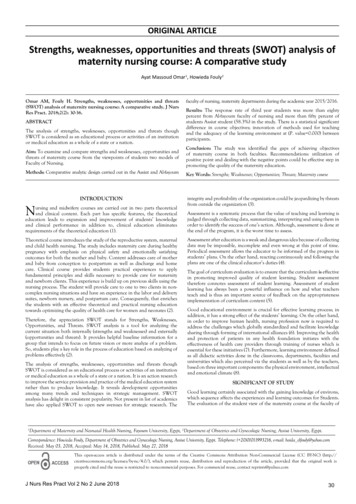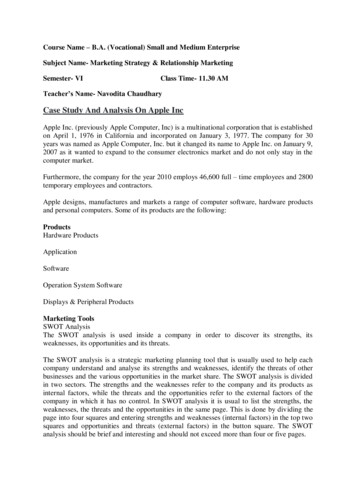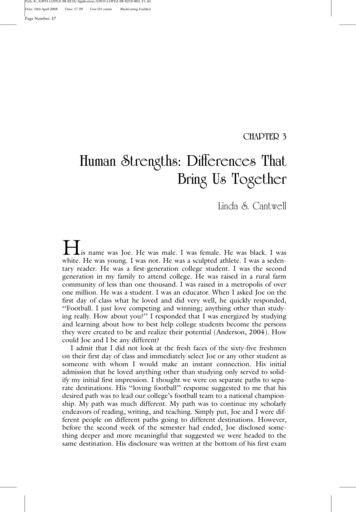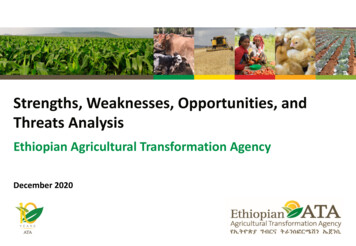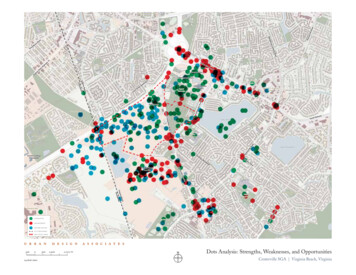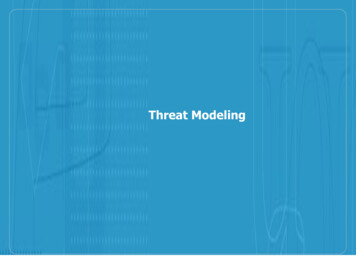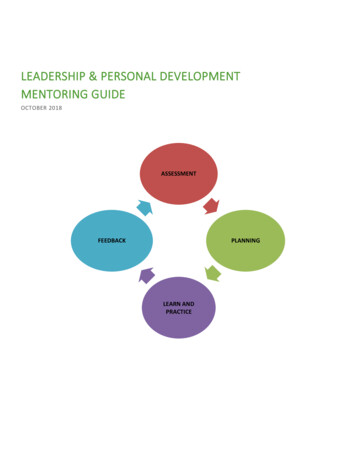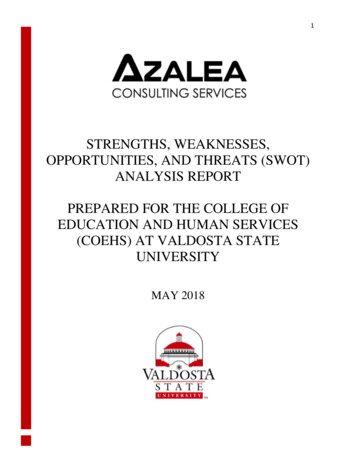
Transcription
1STRENGTHS, WEAKNESSES,OPPORTUNITIES, AND THREATS (SWOT)ANALYSIS REPORTPREPARED FOR THE COLLEGE OFEDUCATION AND HUMAN SERVICES(COEHS) AT VALDOSTA STATEUNIVERSITYMAY 2018
2AcknowledgementsThe report is an effort of Keith Waugh, PhD., Leon Pate, PhD., Kate Warner, PhD., JeremyBauer, PhD., and the following members of Azalea Consulting Services: Jacob Highsmith,Natalie Evans, Kennedy Drury, Nicolas Cecchini, Joseph Jones, and David Daniel.Comments about this report can be sent to Dr. Jeremy Bauer, Program Coordinator forIndustrial/Organization Psychology, 2103 Converse Hall, Valdosta State University, Valdosta,Ga 31698; telephone 229.333.5440; or email jabauer@valdosta.edu.
3Table of ContentsAcknowledgements. 2Executive Summary. 4Introduction . 6Method . 6Results . 8Table 1: Strengths . 12Table 2: Weaknesses . 17Table 3: Opportunities . 21Table 4: Threats . 25Discussion. 26Figure 1: SWOT Matrix . 29Appendix A: SWOT Survey . 30Appendix B: . 33
4Executive SummaryThis report summarizes the results from the recent Strengths, Weaknesses, Opportunities,and Threats (SWOT) survey distributed to the Dewar College of Education and Human Services(COEHS) at Valdosta State University (VSU). The SWOT analysis seeks to uncover faculty andstaff opinions of the current strengths, weaknesses, opportunities, and threats of the COEHS. Theanalysis of the SWOT data was conducted by a student-based consulting group, AzaleaConsulting Services. Upon request of Dean Oliver the SWOT analysis was created anddistributed to faculty in the COEHS. The goals, objectives, and timeline of the distribution andanalysis were coordinated by Dean Oliver, Dr. Waugh, Dr. Pate, Dr. Warner, and Dr. Bauer.Information was disseminated via Dr. Bauer to project leaders within Azalea. The surveycreation process, the survey implementation, and the survey analysis were all reviewed by Dr.Bauer, Dr. Waugh, Dr. Pate, and Dr. Warner.The survey was created and disseminated to faculty within the COEHS using theQualtrics Research Suite. The survey was available from April 23, 2018 until May 15, 2018.After data collection the statements were thematically coded by members of Azalea ConsultingServices. The thematic coding sought to identify themes within each component of the SWOT.Once thematic categories were identified statements that were coded into each theme allowingfor frequency information to be computed. The qualitative and quantitative information providedin this report may be useful for future efforts related to strategic planning within the COEHS.The survey was disseminated via email to COEHS faculty. The total number ofcompleted or partially completed surveys was 86. The respondents identified that they were frommultiple departments within the COEHS. The departments represented were; Adult and CareerEducation (n 7), Curriculum, Leadership, and Technology (n 11), Elementary Education (n 6), Communication Sciences and Disorders and Special Education (n 5), Middle Grades,Secondary, Reading, and Deaf Education (n 8), Social Work (n 3), Psychology, Counseling,and Family Therapy (n 21), Kinesiology and Physical Education (n 1), Library andInformation Sciences (n 1), Dean’s Office (n 1). Some respondents declined to identify thedepartment in which they were currently working (n 21). On average the respondents havebeen working at VSU for 10.38 (SD .72) years. Respondents identified working at VSU aminimum of one year and a maximum of 25 years.Participants provided responses for each component of the SWOT analysis. Theresponses were reviewed by subject matter experts to identify themes within each category of theSWOT analysis. Our coders sorted statements into the identified thematic categories. Inter-rateragreement was utilized during team coding sessions to ensure correct categorization. Multiplereviews were conducted to ensure adequate sorting of the response statements and to assess theinterpretability of the themes. As themes developed they were labeled based on the statementscontained within. The labels are similar across SWOT components yet are uniquely definedacross SWOT components. Interpretation of the themes should not be attempted withoutadequate understanding of the themes unique definition.The frequencies of each SWOT category can be found in Tables 1, 2, 3 and 4. Thefrequency data allows for comparisons to be made between themes within each SWOTcomponent. Some broad comparisons that can be made involve the overall responses between
5each SWOT component. Survey respondents generated more statements when discussing theweaknesses (n 437) than when discussing strengths (n 337) of the COEHS. Furthermore,respondents generated a relatively comparable number of statements when discussing theopportunities (n 311), and threats (n 305) facing the college.In regard to the strengths of the COEHS, the quality of our talent (n 91) was the mostfrequently reported. Both the faculty/staff (n 81) and leadership (n 10) were identified as astrength. Resources (n 68) were also considered a strength particularly when discussing travelsupport (n 18) and the copy center (n 14). When discussing weaknesses, resources were themost frequently reported (n 129) including perceptions of a general lack of support (n 28), alack of support for faculty and staff lines (n 22), and a lack of support for the human serviceprograms (n 32). The policies, procedures, and bureaucracy (n 101) were also identified as aweaknesses of the college especially when discussing promotion and tenure policies (n 30),perceived fairness (n 17) and syllabi requirements (n 16).In regard to the opportunities available to COEHS, engaging in more strategic planninginitiatives (n 58) was frequently discussed with many respondents indicating that we shouldensure that we are aligning with VSU’s strategic plan and providing support to the recruitment ofhigh quality students in addition to adequately marketing our programs, centers, and outreachclinics (n 28). Curriculum and Course offering related opportunities were also popular (n 57)with general recommendations (n 28) and the addition of 4 1 programs (n 16) being themost popular sub-domains. When discussing threats, lack of resources in the COEHS (n 72)was the most frequently reported issue with lack of support for faculty/staff lines (n 26) andgeneral budget constraints (n 15) consistently emerging as themes. Finally, threats related toour policies, procedures, and bureaucracy (n 40) were frequently reported with perceivedunfairness (n 18) related to monetary resources and general workload. A more fine-grainedanalysis of the SWOT is provided in the discussion section (See page 26).
6IntroductionThe purpose of a SWOT analysis is to uncover and identify the specific strengths,weaknesses, opportunities, and threats of an organization. The responses are typically providedby current incumbents of the organization. The four components of a SWOT analysis can becategorized by potentially helpful factors (e.g., strengths and opportunities) and potentiallyharmful factors (e.g., weaknesses and threats). Furthermore, the strengths and weaknessesportions of the SWOT are meant to be an assessment of internal factors. The opportunities andthreats portions of the SWOT are meant to be an assessment of external factors. An examplematrix depicting these categorizations can be found in Figure 1. If done correctly, a SWOTanalysis should provide a realistic portrait of the environmental landscape that the organization iscurrently facing. Additionally, the information yielded from the SWOT analysis should bepresented in a highly organized fashion in order to maximally aid future strategic planningefforts.Conducting a SWOT analysis is frequently recommended to organizations interested instrategic planning. The popularity of the SWOT is not surprising as a SWOT analysis can oftenprovide a great deal of utility to the organization. More specifically, a SWOT analysis can act asa barometer of the current state of the organization. However, there are several caveats thatshould be mentioned before interpreting the results of a SWOT analysis. First, the data is oftencollected from current internal employees over a specified amount of time (e.g., half day or threeday workshops). Thus, the information yielded from a SWOT analysis can become quicklyobsolete with changing environments and can be deficient in regard to external information. Forinstance, external customers are often able to identify weaknesses and opportunities for anorganization that incumbent employees are unable to identify. Additionally, a SWOT analysisoften produces qualitative data from incumbent employees. This data can be difficult to interpretat a macro level as quantifying the data requires investigators to make assumptions andgeneralizations regarding the observed statements. The qualitative data provided is alsosusceptible to contamination from biasing sources such as shared group climates, organizationalpolitics, and careless responding. Finally, a SWOT analysis often fails to prioritize thecomponents or generate a great deal of potential solutions to the identified problems. Thus, aSWOT analysis is often considered descriptive in nature.Since a SWOT analysis has several potential limitations, conducting a SWOT analysis isoften only the first step of using data to inform the strategic plan. Data analyses related tostrategic planning should be a sustained effort across several initiatives. For instance, industry orgovernmental data may provide useful metrics for decision making at the organizational level.Additional analyses (e.g., needs analysis) and subject matter experts may also provide usefulinformation. Thus, we recommend the current investigation to be followed by a host of strategicplanning initiatives to enhance the decision making capabilities of the COEHS. Regardless, theinformation contained in the current report provides useful information for those interested indeveloping a strategic plan for the COEHS.MethodParticipantsThe survey elicited a total of 86 partial or completed responses from faculty and staffwithin COEHS. Responses originated from a wide host of departments including Adult andCareer Education (n 7), Curriculum, Leadership, and Technology (n 11), Elementary
7Education (n 6), Communication Sciences and Disorders and Special Education (n 5),Middle Grades, Secondary, Reading, and Deaf Education (n 8), Social Work (n 3),Psychology, Counseling, and Family Therapy (n 21), Kinesiology and Physical Education (n 1), Library and Information Sciences (n 1), Dean’s Office (n 1). Some respondents declinedto identify the department in which they were currently working (n 21). On average therespondents have been working at VSU for 10.38 (SD .72) years. Respondents identifiedworking at VSU a minimum of one year and a maximum of 25 years.ProcedureThe survey was created using the Qualtrics research suite and was disseminated via emailto COEHS faculty. Data collection took place from April 23, 2018 until May 15, 2018.Anonymity of participants was assured to increase participation and honest responses. The onlyidentifiable information collected was two demographic questions included at the start of thesurvey. Participants were asked to indicate how many years they have worked at VSU and whatCOEHS department of office they currently work in. Participants were not required to respond toeither question. While demographic information was retained during thematic coding, thedemographic information was analyzed separately for frequency and was not connected with anyresponses. The SWOT survey was adapted from an existing scale provided by Dr. Pate.Respondents were given a general prompt to answer each portion of the SWOT analysis. Thecomponents of the SWOT were defined to aid participant understanding. Participants were askedto provide a minimum of three responses per SWOT question. However, participants wereallowed to respond a total of 10 times per SWOT question. Thus, a fully completed surveyresponse could yield up to 40 independent statements regarding the perceived strengths,weaknesses, opportunities and threats of the SWOT. The finalized Qualtrics survey can beviewed in Appendix A.Before analyzing the data, participants were removed if they did not complete any of theSWOT items or if they only completed the demographic variables. A total of 13 responses wereremoved from the dataset. After the data was cleaned a team of subject matter experts met toanalyze the data for emerging themes. Our method involved having three or more independentcoders sort each statement into domains (i.e., themes) that they perceived to emerge throughoutthe sorting process. The constructs that emerged from the sorting were organized by levels to aidin interpretation. The highest level was labeled domain, the next level was labeled sub-domain,and the lowest level was labeled sub-category. Inter-rater agreement was utilized to ensureaccuracy of the sorting process. A statement was not sorted into a domain without consensusfrom all raters present during the sorting session. Occasionally, the coders would encounterstatements that could be classified into two categories. These statements were double coded andare marked with an asterisk (*) in Appendix B. Since the initial round of sorting had themesemerging simultaneously and because the sorting team varied over time, a second round ofsorting was conducted to verify and improve the accuracy of the first round. The second round ofsorting resulted in the reclassifications of several statements. Additionally, new themes emergedand a few were removed or merged together. For instance, the domain of COEHS climateemerged as an important domain in the second round of coding. Several statements that weremarked as general or misclassified in the first round of sorting were sorted into the domain ofclimate in the second round. This resulted in a more organized and parsimonious content domain.
8Although similar themes emerged across portions of the SWOT analysis, themanifestation of these themes often varied across the four sections of the SWOT analysis. Forinstance, diversity emerged as a domain across both strengths and weaknesses. However, thefrequency of responses and the sub-domains that emerged within both categories variedconsiderably between the two constructs. The thematic labels presented in the current reportwere created to allow for more meaningful interpretation of the data but care should be takenwhen interpreting these results as sorting qualitative statements is a subjective process. The fulllist of thematic categories and the coded statements can be found in Appendix B.Considerations for interpreting the dataBefore interpreting the results of the current SWOT analysis, there are several caveatsthat should be discussed. More specifically, there was no limit placed on the amount of times arespondent could submit a survey response. Thus, it is possible that some of the survey responseswere generated by the same respondent. Thus, the emergent themes identified here may beinflated. Another consideration involves the double coding of several statements. Detailedresponses may inflate frequencies across domains as the same statement is counted twice acrossdomains. Finally, although a SWOT analysis is designed to separate statements across fourconstructs (e.g., strengths, weaknesses, opportunities, threats). However, the categories of theSWOT are not orthogonal. Thus, respondents can have trouble correctly identifying theirstatement in relation to these constructs. For instance, slight changes in the wording of astatement can cause individuals to reclassify a weakness as an opportunity or even threat. Inregard to the current investigation, we asked respondents to give us statements that they believedto be strengths, weaknesses, opportunities, and threats. Thus, there are likely misclassificationswithin each category. To maintain the quality of the data, we did not reclassify statements acrosscategories that were identified as not representing the category. Instead, we kept the statementwithin the category but labeled it as a potential misclassification.ResultsOnce the construct domain was identified within each category of the SWOT analysis,frequencies of associated statements were calculated for each domain, sub-domain, and subcategory. Statements that were double- or triple-coded statements were counted multiple timesthroughout the report (See tables 1-4). A general domain was created to categorize statementsthat were related to the domain but did not fit clearly into any of the sub-domains or subcategories.StrengthsStrengths are defined as internal characteristics that are unique, special, highly valued,and positive relative to the COEHS. The Strengths component of the SWOT analysis contains337 statements categorized into 11 domains. Strengths had the second highest quantity ofassociated statements. The content domain and frequency data can be found in Table 1.Quality of Talent. The most frequently reported strength of the COEHS is the quality ofour talent (n 91). Talent refers to the quality of COEHS administration, faculty, and staff.Comments ranged from simply stating “faculty” as a strength to listing specific characteristicsthat are considered strengths of the faculty and staff (e.g., “Most faculty work very hard in
9advising students”). Two sub-domains emerged from the quality of talent domain (e.g. facultyand staff and leadership quality).Faculty and Staff. The faculty and staff sub-domain refers to the expertise and quality ofCOEHS faculty and staff. General Faculty and Staff statements (n 54) had the greatestfrequency within the quality of talent domain. These statements ranged from “faculty expertise”to “the support staff is excellent.” Two additional sub-categories emerged within this subdomain.The commitment/dedication sub-category (n 19) refers to the effort, care, and loyalty of facultyand staff in relation to their jobs and their students. Statements ranged from “caring faculty” to“hard working faculty.” The student-centered sub-category (n 8) refers to the COEHS’ focuson students and providing good customer service. Statements ranged from “student centered” to“customer focus.”Leadership Quality. The leadership quality sub-domain (n 10) refers to leadership atthe department, college, and university levels. Items typically included positive statements aboutnew leadership and leadership accessibility.Resources. The second most frequently reported strength is resources (n 68) and refersto the tangible items, funding, and support provided by the COEHS. The statements referred togeneral resources (n 13) provided by the COEHS such as “polos for faculty are a really greattouch.” The resources domain consists of five sub-domains (e.g., technology, travel, funding,copy center, and certification support).Technology. The sub-domain technology (n 9) included statements related to theutilizations of technology. The majority of statements specifically referred to the “informationmonitor system.”Travel. The sub-domain travel (n 18) involved funds, support, or accessibilityspecifically related to the ability to travel. It was the most frequently reported sub-domain ofresources. Statements regarding travel included “Travel Proxy” or “Travel Support.”Funding. The sub-domain funding (n 7) includes statements involving funding typessuch as grants, scholarships, and awards. Most statements referred to the student awards andscholarships provided by the COEHS.Copy Center. The sub-domain copy center (n 14) focused on statements that dealt withthe COEHS’ copy center. The copy center appears to be considered a strength by multiplerespondents.Certification Support. The sub-domain certification support (n 7) includes statementsreferring to certification support. The majority of statements mentioned general certificationsupport or GACE support.Diversity. The third most frequently reported strength is the diversity of the COEHS (n 48). The diversity domain is listed third as it has the third highest frequency count in Strengths (n
10 38). Three sub-domains emerged within the domain of diversity (e.g., diversity of curriculum,diversity of leadership, and diversity of faculty and students).Diversity of Curriculum. The sub-domain diversity of curriculum (n 38) was the mostfrequently reported sub-domain of diversity. The sub-domain included general statements (n 18) referring to the variety of programs that are offered by the COEHS (e.g. social work, MLIS,communication sciences, family therapy, industrial/organizational). Two additional subcategories emerged within the diversity of curriculum sub-domain. Theopportunities/experience/training sub-category (n 13) includes statements that mention avariety of campus based services available to our faculty and students (e.g., study abroadprograms, applied research opportunities, active clinics, and social work micro-practiceexercises). The online sub-category (n 7) includes statements that mention the variety ofprogram offerings the COEHS makes available online.Diversity of Leadership. The sub-domain diversity of leadership (n 3) includesstatements that refer to the growing demographic diversity of administration within the COEHS.Diversity of Faculty and Students. The sub-domain diversity of faculty and students (n 7) includes statements that mainly refer to the demographic diversity of faculty and students inthe COEHS.Culture. The domain culture (n 37) refers to the shared feelings and ideals betweenpeople within the COEHS. There were several general positive statements about the culture ofCOEHS (n 6). Two additional sub-domains emerged within the domain of culture (e.g., annualmeetings and climate).Annual Meetings. The sub-domain annual meetings (n 16) includes statements thatrefer directly to the annual COEHS meetings (e.g., faculty and staff lunches).Climate. The sub-domain climate (n 16) includes statements about the positivecollaborative relationships found within the COEHS.Quality of Programs. The quality of program domain (n 19) refers to the quality ofprograms offered by the College. There were multiple general positive statements about thegeneral quality of programs offered by the COEHS.Regional Service. The regional service domain (n 18) refers to the labs, clinics, orservices that the College offers to aid in the functioning or improvement of the regionsurrounding VSU. All statements were sorted as general regional service. Examples of regionalservice statements include “Azalea Consulting Services” or the “Speech and Hearing Clinic.”Accreditation. The accreditation domain (n 16) refers to the accreditation of programsin the College. The majority of statements focused on the COEHS having accredited programsand having accreditation support.
11Job Procedural Clarity. The job procedural clarity domain (n 15) refers to the amountof transparency provided by administration. Job procedural clarity means that employeesunderstand their roles and the policies and procedures that govern their work environment. Jobprocedural clarity statements often referred positively to the structure and consistency ofexpectations within the COEHS.Misclassified. The misclassified domain contains statements that did not appear to fitinto any of the thematic categories identified for Strengths (n 15). Statements were sorted intomisclassified if they did not pertain specifically to the college, were nonspecific, or did not addany value (e.g. I wish I had more, potential, and I just can’t think of any).Perception/Reputation. The perception/reputation domain (n 6) includes statementsabout the positive regional and state opinions of COEHS programs.Organizational Structure. The organizational structure domain refers to the internalarrangement of the departments and the college itself. The organizational structure domain hadthe least amount of statement within Strengths (n 3). General organizational structurestatements referred to the sizes and structure of the departments in the COEHS.
12Table 1Frequency data for the domains, sub-domains, and sub-categories of StrengthsDomains/Sub-Domains/Sub-CategoriesQuality of Talent (Grand Total)a. Faculty and Staff (Subtotal)i. General (Subtotal)ii. Commitment/Dedication (Subtotal)iii. Student-Centered (Subtotal)b. Leadership Quality (Subtotal)2. Resources (Grand Total)a. General (Subtotal)b. Technology (Subtotal)c. Travel (Subtotal)d. Funding (Subtotal)e. Copy Center (Subtotal)f. Certification Support (Subtotal)3. Diversity (Grand Total)a. Diversity of Curriculum (Subtotal)i. General (Subtotal)ii. Opportunities/Experience/Training (Subtotal)iii. Online (Subtotal)b. Diversity of Leadership (Subtotal)c. Diversity of Faculty and Students (Subtotal)4. Culture (Grand Total)a. General (Subtotal)b. Annual Meetings (Subtotal)c. Climate (Subtotal)5. Quality of Programs (Grand Total)6. Regional Service (Grand Total)7. Accreditation (Grand Total)8. Job Procedural Clarity (Grand Total)9. Misclassified (Grand Total)10. Perception/Reputation (Grand Total)11. Organizational Structure (Grand 3761516191816151563Note. Numbers indicate domains. Lower-case letters indicate sub-domains. Lower-case romannumerals indicate sub-categories. Frequency data is included for each domain, sub-domain, andsub-category. Grand Total indicates the overall frequency for the domain. Subtotal indicates thefrequency for the subdomain or subcategory.
13WeaknessesWeaknesses were defined as internal challenges that the COEHS faces or limitations toachieving missions and goals. The weaknesses component of the SWOT analysis contains 437statements categorized into eight domains. Multiple sub-domains and sub-categories wereidentified to increase the interpretability of domains. The weaknesses component contains thegreatest quantity of statements. The frequency data can be found in Table 2. The uniquedefinitions of each domain, sub-domain, and sub-category are explored as well as thecomparisons within and between SWOT components.Resources. The resources domain of Weaknesses has the greatest frequency ofstatements within Weaknesses (n 129). Resources are the tangible and intangible assetsprovided by the COEHS to departments, faculty, and staff. General resource statements (n 28)varied in content (e.g. weak alumni relationships and lack of infrastructure). Seven sub-domainswere identified (e.g. faculty/staff, travel, child care, funding, programs/department, technology,support non-education majors.)Faculty/Staff. The faculty and staff sub-domain (n 22) contains statements thatprimarily refer to the lack of funding for full-time faculty, increased turnover, and misuse ofpersonnel.Travel. The travel sub-domain (n 13) includes statements that primarily address a lackof travel and conference funding for students.Child Care. The child care sub-domain (n 7) contains statements the primarily addressthe lack of child care services made available within the COEHS.Funding. The funding sub-domain (n 9) contains statements that primarily address thelack of funding for department, programs, and faculty.Programs/Department. The programs/department sub-domain (n 7) includesstatements that primarily deal with the non-monetary support of programs and departments.Response statements range in content from “supporting the special education program” tostatements about class sizes being a problem.Technology. The technology sub-domain (n 11) contains statements that primarily dealwith the lack of faculty technology skills and the need for updated and equitable availability ofupdated technology.Support for Non-Education Majors. The support lacking for non-education majors subdomain (n 32) contains statements that primarily deal with the lack of resources and supportfor the human services departments within the COEHS. The general (n 22) sub-domaincontains statements related to the lack of accreditation support for non-education programs. Asub-category related to a lack of professional development opportunities for faculty and staff inthe human services (n 10) also emerged.
14Policies, Procedures, and Bureaucracy. The policies, procedures, and bureaucracydomain (n 101) consists of statements dealing with the stifling and infle
The SWOT analysis seeks to uncover faculty and staff opinions of the current strengths, weaknesses, opportunities, and threats of the COEHS. The analysis of the SWOT data was conducted by a student-based consulting group, Azalea Consulting Services. Upon request of Dean Oliver the SWOT analysis was created and distributed to faculty in the COEHS.

